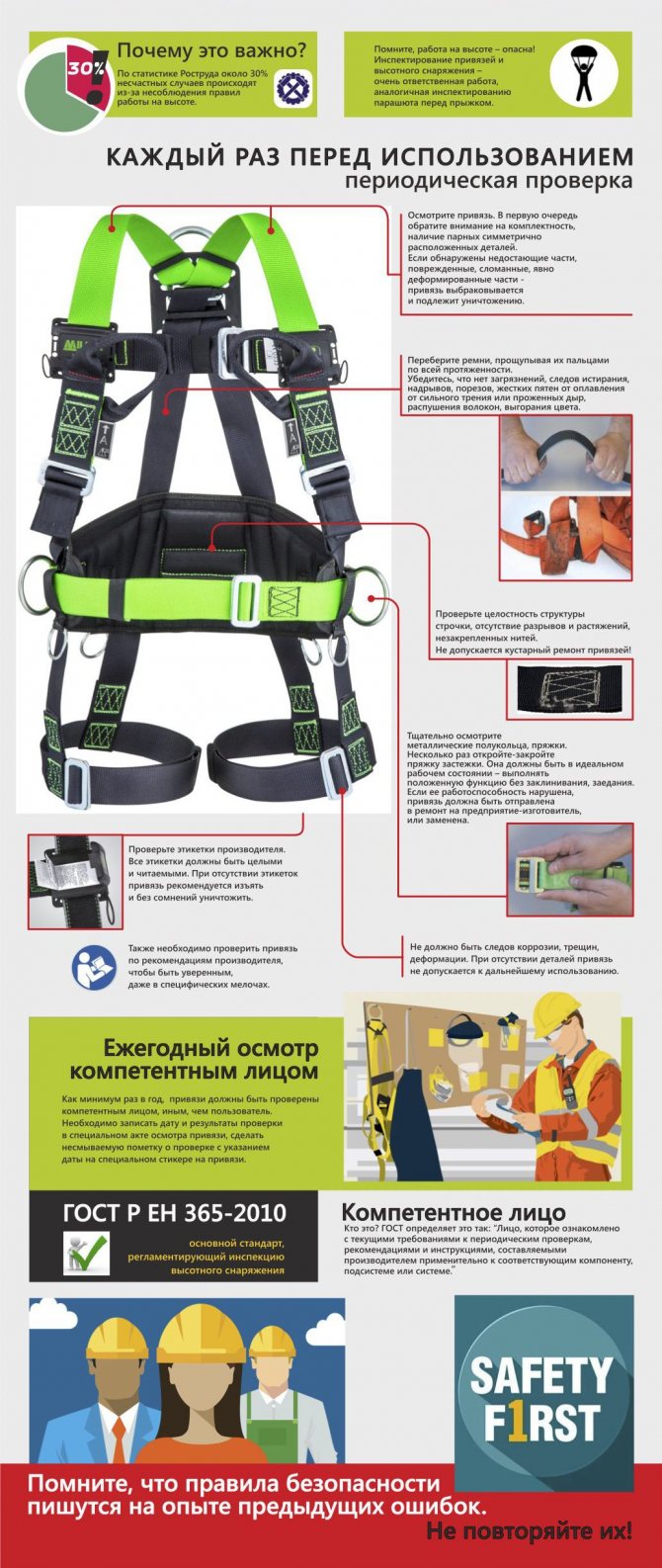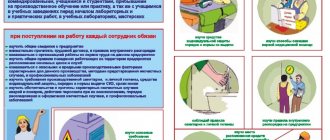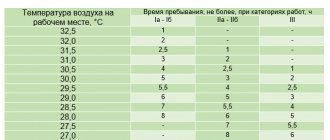What is the age limit for working at height?
Good afternoon. The restriction is established by Order of the Ministry of Labor of Russia dated March 28, 2014 N 155 n “On approval of the Rules for labor protection when working at height”
▪ In accordance with current legislation, workers performing work at height must undergo mandatory preliminary (upon entry to work) and periodic medical examinations.
▪ Workers performing work at height must have qualifications appropriate to the nature of the work performed. The level of qualification is confirmed by a document on professional education (training) and (or) qualifications.
| There is also “POT RO 14000-005-98. Position. Work with increased danger. Organization of the event”, which says that: |
clause 5. Persons who have reached the age of eighteen are allowed to work at height.
17.1.3. Workers who are not younger than 18 years of age and not older than 60 years of age , who have passed a medical examination for suitability for steeplejack work, who have an installation qualification of at least the 3rd category, who have been trained in the rules for the safe performance of steeplejack work, who have the necessary training and practical skills to perform it, are allowed to perform steeplejack work, having undergone special instructions at the workplace before starting each work, and having the appropriate certificate of admission to steeplejack work.
The procedure for training in labor protection and testing knowledge of labor protection requirements for employees of organizations, approved by Resolution of the Ministry of Labor of Russia and the Ministry of Education of Russia dated January 13, 2003 N 1/29 (registered by the Ministry of Justice of Russia on February 12, 2003, registration N 4209).
Key safety rules for working at height
Achieving an appropriate level of labor protection when working at height is unthinkable without the provision of regulated personal protective equipment (PPE). The management of enterprises is required to purchase and issue the required amount of prescribed PPE. The choice is made in accordance with approved standards, depending on the responsibilities of the personnel and the nature of their production duties, and the professional orientation of the employee.
Read also: Law on garbage removal
An employee is removed from a task if they do not receive the appropriate PPE or if the protective equipment is damaged.
Use of rope access systems
PPE is designed to eliminate exposure to harmful and hazardous production factors. They are classified depending on which organ or part of the body they protect. Provision is made for the provision of protective clothing and safety footwear, safety helmets, etc.
In accordance with the new Rules, these conditions provide for the use of holding and positioning systems, safety ropes, and safety belts.
Personnel involved in performing high-altitude tasks are divided into groups according to the degree of responsibility:
- the first is the working personnel making up the team, under the command of a foreman or other managerial employee;
- the second - line managers and foremen;
- the third is the engineering and technical staff appointed as responsible persons, members of the certification commission and other employees from senior management.
The danger associated with being at high altitudes is typical for many professions - installers, builders, painters, repairmen, etc.
Regulated requirements for enterprise management
The employer is required to perform the following responsibilities to ensure the necessary safety conditions:
- assignment of control to the person responsible for the specified work by order of the enterprise;
- the creation of a certification commission to test the knowledge of personnel involved in high-altitude work;
- personnel training with the involvement of licensed organizations;
- ensuring the availability of PPE and their timely replacement, installation of protective equipment intended for collective use (SCP - scaffolding, scaffolding, fencing);
- conducting regular briefings for employees;
- implementation of organizational measures - compliance with the admission system, approval of work permits, etc.
The employer is responsible for the adequacy of the measures taken. The degree of fulfillment of these tasks is determined by the results of inspections carried out by state regulatory authorities, the enterprise's occupational safety service, and statistics on industrial injuries and accidents.
Regulations for attracting personnel to work at heights
People in production can be sent to an elevation to complete a production task if they:
- have reached the age of majority;
- have undergone proper training, with certification confirmed by the issuance of an appropriate certificate of the established form;
- underwent a medical examination, the results of which revealed no contraindications;
- received instructions on labor protection;
- learned the skills acquired during training and instruction during an internship under the guidance of an experienced employee.
Personnel are required to use the prescribed PPE and SCP and monitor their serviceability. If, during the course of work, reasons are identified that impede safety, the employee is obliged, without starting the task, to contact the manager with a request to eliminate these factors.

Periodically checking equipment before use
The employee is responsible for compliance with safety requirements in accordance with current legislation.
What regulatory document defines age restrictions when working at height?
There is no age limit for working at height. If honey inspections pass successfully, can work.
1.2. Work with increased danger - work (except for emergency situations), before the start of which it is necessary to carry out a number of mandatory organizational and technical measures to ensure the safety of workers when performing this work.
17.1.1. Work at height includes work during which the worker is located above 1 m from the floor, ceiling, or working floor, and for their production scaffolding and scaffolding must be installed.
| "POT RO 14000-005-98. Position. Work with increased danger. Organization of the event" |
7. Workers performing work at height must have qualifications appropriate to the nature of the work performed. The level of qualification is confirmed by a document on professional education (training) and (or) qualifications.
6. In accordance with current legislation, workers performing work at height must undergo mandatory preliminary (upon entry to work) and periodic medical examinations.
1.3. Taking into account the specifics of each organization, a list of high-risk work must be developed, which must be agreed upon with the trade union committee or other representative body authorized by the employees and approved by the chief engineer (technical director) of the organization.
Work at height
Failure to carry out certification does not relieve the employer of the obligation to provide an employee engaged in heavy work, work with harmful and (or) dangerous working conditions, additional payments and compensation (Resolution of the Presidium of the Altai Regional Court dated 09.08.2011 N 44 g-43/2011, Decision of the Leninsky District Court of Ufa dated 08.08.2012 in case No. 2-2912/12).
To establish the appropriate amount of compensation, the employer may use:
▪ Persons who have reached the age of eighteen are allowed to work at height. ▪ In accordance with current legislation, workers performing work at height must undergo mandatory preliminary (upon entry to work) and periodic medical examinations. ▪ Workers performing work at height must have qualifications appropriate to the nature of the work performed. The level of qualification is confirmed by a document on professional education (training) and (or) qualifications. ▪ Workers are allowed to work at height after completing: a) training and testing of knowledge of labor protection requirements;
Within the meaning of Art. Art. 146, 147 of the Labor Code of the Russian Federation, increased pay is provided specifically for actual work under special conditions. Therefore, the employer is obliged to pay at an increased rate for all hours when the employee actually worked under these conditions, regardless of whether the work was carried out within or in excess of the monthly working hours, on a scheduled working day or on a weekend or non-working holiday.
In addition to the above-mentioned compensations for employees whose work involves hazardous working conditions, milk or other equivalent food products are provided free of charge according to established standards (Article 222 of the Labor Code of the Russian Federation). Based on written statements from employees, the provision of milk and other equivalent products may be replaced by monetary compensation if this is provided for in the collective and (or) labor agreement.
Work restrictions by age
Classification of information products is carried out in accordance with the requirements of this Federal Law into the following categories of information products:
▪ peculiarities of perception of the information contained in it by children of a certain age category;
Order of the Ministry of Labor of Russia dated March 28, 2014 N 155 n “On approval of the Rules for labor protection when working at height” (Registered with the Ministry of Justice of Russia on September 5, 2014 N 33990) II. Persons over the age of eighteen are allowed to work at height. There are a number of other conditions not related to age.
▪ Classification of information products intended and (or) used for teaching and raising children in educational institutions implementing, respectively, basic general education programs, basic professional educational programs of primary vocational education, secondary vocational education, in educational institutions of additional education for children, is carried out in accordance with this Federal law and legislation of the Russian Federation in the field of education.
Hello. The Labor Code regulates the relationship between the employee, the employer and the state. Labor Code of the Russian Federation. Article 72.1. Transfer to another job. Moving
Basic Safety Precautions
In order to eliminate the possibility of accidents and injuries at work, and to ensure labor safety requirements when working at height, the conditions stipulated by the standards must be strictly observed:
- Before starting the task, make sure that the technical devices, equipment and safety equipment used are in good working order;
- check the PPE received;
- constantly use safety equipment during the execution of the task;
- resort to standard techniques provided for in the instructions;
- do not approach sources of danger;
- not to be under an employee working on a higher tier without using special means;
- do not violate the requirements of the instructions and operational regulations;
- work according to the given assignment.
Read also: Registration of drones in Russia
Most accidents associated with work at height are caused by hasty and thoughtless actions, violation of rules and prescribed labor protection requirements.
What kind of work is considered work at height?
1.9. Carrying out work at height must be provided with the necessary serviceable protective equipment in accordance with GOST 12.4.059 and protective devices in accordance with GOST 27321.
1.1. The administration is obliged, before the start of work, to familiarize workers associated with work at height with these instructions, test their knowledge and constantly monitor compliance with its requirements, as well as provide workers with special clothing, safety footwear and personal protective equipment in accordance with current standards and the nature of the work performed.
1.3. Climbing work is considered to be work that is performed at a height of more than 5 m from the surface of the ground, ceiling or working floor, on which work is carried out directly from structures, equipment, machines and mechanisms during their installation, dismantling and repair, when the main means of protecting the worker from falling from height when working and moving is a safety belt.
1.8. Workers must have the necessary working tools and equipment, safety signals and devices, and protective devices necessary for work. It is prohibited to carry out work with faulty tools and equipment.
1.4. Workers who are not younger than 18 years old and not older than 60 years old, who have passed a medical examination for suitability for steeplejack work, who have an installation qualification of at least 3rd category, who have been trained in the rules for the safe performance of steeplejack work, who have the necessary training and practical skills to perform them, who have passed before the start of each work, special instructions at the workplace, having the appropriate certificate of admission to steeplejack work.
Read other lawyers' answers:
- How to draw up a House Purchase Agreement
- How to Postpone a Court Hearing in an Arbitration Case
- How to Get Transit Numbers for a New Car
- How to Get a Street Selling Permit
- How long are New Year's holidays?
Dear colleagues, I wish each of us to hold high the title of lawyer, unswervingly adhering to the principles of impartiality and objectivity!
FAQ:
When does an employee work at height?
Only if the following points are observed:
- the employee is an adult and has undergone a medical examination;
- has the necessary qualifications, has undergone proper training, which is confirmed by a certificate;
- received a permit and received instructions.
Which of the following works relate to work at height?
These include work that has the characteristics indicated in paragraph 3 of Order of the Ministry of Labor 155n, namely if the employee has a risk of falling from a height of 1.8 m, if he needs to climb stairs to a height of more than 5 m, if tasks are performed with a risk of falling over equipment, protruding structures, etc. or if the work area is located on a site located at a height of 180 cm, not fenced with railings or with a fence less than 110 cm.
Popular tags
Committing a crime Composition of a crime Article of the Criminal Code car administrative initiation civil money activity document complaint law statement health property execution supervision punishment sample application release grounds liability refusal to submit police receiving order resolution right preliminary termination involvement causing harm production prosecutor's office prosecutor process decision witness investigation deadlines judicial condition petition storage







